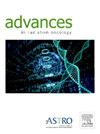具有明确分子亚型的髓母细胞瘤患者的治疗结果和预后因素
IF 2.7
Q3 ONCOLOGY
引用次数: 0
摘要
目的本研究旨在评估具有明确分子亚型的髓母细胞瘤(MB)患儿的治疗结果和预后因素,为后续的个体化治疗提供依据。方法与材料回顾性分析2017年1月至2021年在我院接受放射治疗(RT)的145例具有明确分子亚型的MB患者。患者分别进行传统的临床风险分层、分子风险分层和国家综合癌症网络(NCCN)风险分层。分析治疗结果及相关预后因素。结果中位随访49个月,5年无事件生存率(EFS)和总生存率分别为68.6%±4.0%和74.7%±4.4%。多因素分析显示,放疗后未能达到完全缓解(5年EFS为39.3%±9.2% vs 75.7%±4.2%;P = .007),给予少于6个化疗周期(5年EFS 25.0%±11.6% vs 73.9%±4.0%;P & lt;.001),并被归类为NCCN高危组成员(5年EFS 48.0%±6.5% vs 84.5%±4.2%;P = 0.040)与较差的预后相关。20例(27.4%)临床标准风险患者根据NCCN风险分层被重新分类为低风险或高/极高风险,5年EFS发生率分别为100.0%±0.0%和58.3%±16.1%。进一步的亚组分析(N = 103)显示,1q增加的患者(5年EFS 32.7%±16.1% vs 67.0%±5.2%;P = 0.035), 10q损失(5年EFS 25.0%±21.7% vs 69.6%±4.6%;P = 0.024), MYCN扩增(5年EFS 40.0%±15.5% vs 70.8%±4.1%;P = 0.010)或TP53突变(5年EFS 33.3%±13.6% vs 71.9%±4.0%;P = .002)的EFS较野生型差。结论smb是一种异质性疾病,需要结合临床和分子特征进行明确的风险分层,以促进个体化治疗。在本研究中,我们发现放疗后残留疾病、化疗少于6个周期、高危NCCN风险分层是MB患者独立的不良预后因素。本文章由计算机程序翻译,如有差异,请以英文原文为准。
Treatment Outcomes and Prognostic Factors for Patients With Medulloblastoma Having Defined Molecular Subtypes
Purpose
This study aims to evaluate treatment outcomes and prognostic factors in pediatric patients with medulloblastoma (MB) with defined molecular subtypes to inform subsequent individualized treatment.
Methods and Materials
A retrospective analysis was conducted on 145 patients with MB with defined molecular subtypes who underwent radiation therapy (RT) at our institution from January 2017 to 2021. Patients were subjected to traditional clinical risk stratification, molecular risk stratification, and National Comprehensive Cancer Network (NCCN) risk stratification, respectively. The treatment outcomes and associated prognostic factors were analyzed.
Results
With a median follow‑up of 49 months, the 5-year event-free survival (EFS) and overall survival rates were 68.6% ± 4.0% and 74.7% ± 4.4%, respectively. Multivariate analysis revealed that failure to achieve a complete response after RT (5-year EFS 39.3% ± 9.2% vs 75.7% ± 4.2%; P = .007), the administration of fewer than 6 cycles of chemotherapy (5-year EFS 25.0% ± 11.6% vs 73.9% ± 4.0%; P < .001), and categorization as a member of the NCCN high-risk group (5-year EFS 48.0% ± 6.5% vs 84.5% ± 4.2%; P = .040) were associated with a worse prognosis. Twenty (27.4%) clinical standard-risk patients were reclassified as low risk or high/very high risk according to the NCCN risk stratification with 5-year EFS rates of 100.0% ± 0.0% and 58.3% ± 16.1%, respectively. Further subgroup analysis (N = 103) revealed that patients with 1q gain (5-year EFS 32.7% ± 16.1% vs 67.0% ± 5.2%; P = .035), 10q loss (5-year EFS 25.0% ± 21.7% vs 69.6% ± 4.6%; P = .024), MYCN amplification (5-year EFS 40.0% ± 15.5% vs 70.8% ± 4.1%; P = .010) or TP53 mutation (5-year EFS 33.3% ± 13.6% vs 71.9% ± 4.0%; P = .002) had a worse EFS than those with wild type.
Conclusions
MB is a heterogeneous disease that requires the integration of clinical and molecular features for defined risk stratification to facilitate individualized treatment. In this study, we found that residual disease after RT, fewer than 6 cycles of chemotherapy, and high-risk NCCN risk stratification were independent adverse prognostic factors for patients with MB.
求助全文
通过发布文献求助,成功后即可免费获取论文全文。
去求助
来源期刊

Advances in Radiation Oncology
Medicine-Radiology, Nuclear Medicine and Imaging
CiteScore
4.60
自引率
4.30%
发文量
208
审稿时长
98 days
期刊介绍:
The purpose of Advances is to provide information for clinicians who use radiation therapy by publishing: Clinical trial reports and reanalyses. Basic science original reports. Manuscripts examining health services research, comparative and cost effectiveness research, and systematic reviews. Case reports documenting unusual problems and solutions. High quality multi and single institutional series, as well as other novel retrospective hypothesis generating series. Timely critical reviews on important topics in radiation oncology, such as side effects. Articles reporting the natural history of disease and patterns of failure, particularly as they relate to treatment volume delineation. Articles on safety and quality in radiation therapy. Essays on clinical experience. Articles on practice transformation in radiation oncology, in particular: Aspects of health policy that may impact the future practice of radiation oncology. How information technology, such as data analytics and systems innovations, will change radiation oncology practice. Articles on imaging as they relate to radiation therapy treatment.
 求助内容:
求助内容: 应助结果提醒方式:
应助结果提醒方式:


